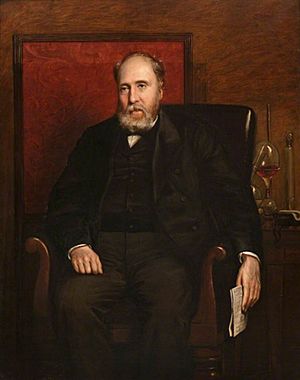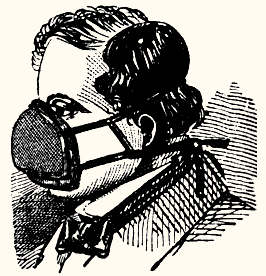John Stenhouse facts for kids
Quick facts for kids
John Stenhouse
|
|
|---|---|

John Stenhouse in 1873
|
|
| Born | 21 October 1809 Glasgow, Scotland
|
| Died | 31 December 1880 (aged 71) London, England
|
| Nationality | Scottish |
| Alma mater | University of Glasgow |
| Known for | John Stenhouse's respirator, betorcinol and erythritol |
| Awards | Royal Medal of the Royal Society of London, 1871 |
| Scientific career | |
| Fields | organic chemistry |
| Institutions | University of Glasgow, University of Giessen, Owens College, Chemical Society of London, St Bartholomew's Hospital |
| Academic advisors | Thomas Graham, Thomas Thomson, Justus Liebig |
| Influenced | August Kekulé |
John Stenhouse (born October 21, 1809 – died December 31, 1880) was a Scottish chemist. He is famous for inventing one of the first useful respirators in 1854. He was also one of the people who helped start the Chemical Society in 1841.
Life and Education
John Stenhouse was born in Barrhead, near Glasgow, Scotland, on October 21, 1809. He was the oldest child of William Stenhouse, who worked as a calico-printer. This was a family business that printed patterns on cloth.
He went to the Glasgow Grammar School. At first, he wanted to study literature, which is about books and writing. But later, he became very interested in chemistry. He studied chemistry at the University of Glasgow and then at Anderson's University in Glasgow. He also spent two years doing chemistry research in Germany with a famous chemist named Justus Liebig at the University of Giessen.
In 1841, John Stenhouse helped create the Chemical Society of London. This is a group for chemists to share their ideas and discoveries. In 1848, he became a Fellow of the Royal Society, which is a very important honor for scientists.
Career and Challenges
For some years, Stenhouse lived on money he inherited from his father. However, in 1850, he lost his money when a company failed. This meant he needed to find a job.
In 1851, he became a chemistry teacher at a medical school in London called St Bartholomew's Hospital. A famous chemist named August Kekulé even worked as his assistant for a while.
In 1857, Stenhouse had a stroke, which made him partly paralyzed. This meant he could not move some parts of his body easily. He had to stop teaching. He went to Nice (which was part of Italy back then) to get better and stay with his mother.
After his mother passed away in 1860, he returned to England. He opened his own laboratory in London. Even though he could not do experiments himself, he hired assistants to help him. These assistants included Raphael Meldola, who also became a well-known chemist. Stenhouse and his assistants wrote over 100 scientific papers together.
From 1865 to 1870, he worked at the Royal Mint, which is where money is made. In 1871, he received the Royal Medal from the Royal Society for his important chemistry research.
John Stenhouse died on December 31, 1880, when he was 72 years old.
Key Discoveries and Inventions
Stenhouse mostly studied organic chemistry. This is the study of chemicals that contain carbon, often found in living things. He was especially interested in chemicals from plants that could be used in medicine or business.
For example, he discovered two chemicals called betorcinol and erythritol. Both of these are found in plants called lichens.
John Stenhouse is most famous for his inventions using wood charcoal. He found that charcoal is very good at soaking up bad smells and harmful gases. He used this idea to create:
- Charcoal air-filters: These filters helped clean the air.
- Charcoal respirators: These were masks that people could wear to breathe cleaner air, especially in places with smoke or bad fumes. This invention was very important for safety.
He also invented new ways to do things like:
- Dyeing fabrics (making them different colors)
- Making materials waterproof
- Making sugar
- Tanning leather (turning animal skins into leather)
- Making glue
His work helped improve many everyday products and safety tools.


